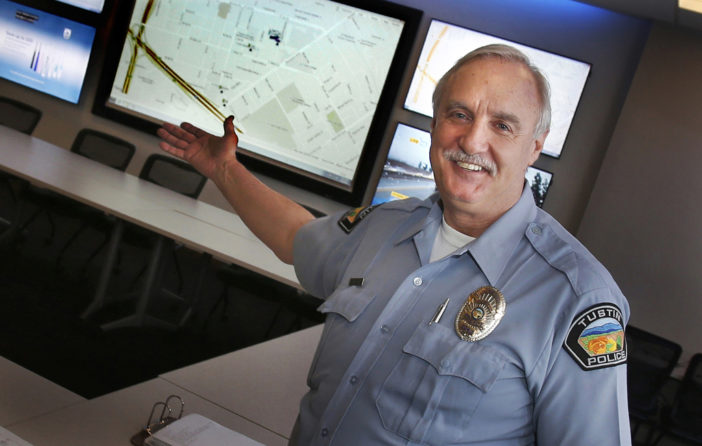As recent rains hammered Tustin, along with rest of Orange County, police responded to the kinds of things wet weather typically brings: car crashes and flooded streets.
The recent El Nino-driven storms were heavy and harder than any rainfall the city has recently experienced so Emergency Management Coordinator Joe Meyers carefully watched.
Water started to rise in the usual areas — mostly pockets of Old Town and underneath the 55 freeway on Main Street — but the rain let up and the streets dried out long before Meyers had to worry about having an emergency on his hands.
“We don’t have a history of flood control systems failing,” Meyers said. “We do pretty well here.”
But Meyers stays diligent because if disaster should strike, Tustin PD will need to spring to action.
With a new Emergency Operations Center (EOC), they are now better equipped to do so.
The Tustin PD in December unveiled its EOC— a modernized briefing room outfitted with the latest technology to help the department run support operations during a catastrophic event.
Major floods or fires, earthquakes, transportation accidents or even an active shooter situation might prompt Tustin PD to make use of the EOC.
“To support and coordinate response between the city, law enforcement and other agencies is the bottom line,” Meyers said. “This is the place we want people to be so we can all be on the same page.”
The room support functions include planning, managing finances, logistics and operations.
Staff in the EOC are responsible for making sure tasks such as ordering supplies or coordinating shelter for people and pets run smoothly, while officers and other responders in the field take care of the tactical operations.
This system is an efficient way to get help to the people who need it, Meyers said.
“The whole point of disaster operations is to get to a place where you can recover and people can get on with their normal lives,” he said.
Meyers said he has been working for three years to help plan, design and oversee construction of the center, which was paid for by a state emergency management grant and city funds.
The room, located on the first floor of the Police Department, had not been updated since Tustin PD’s current facility opened in 1992, Meyers said.
The old room had one large screen, two tube televisions and capacity for 10 phone lines.
In a city with more than 70,000 residents and an unincorporated community with upwards of 25,000 people, Meyers said trying to handle a major emergency with those kinds of resources would be nearly impossible.
“We are unique because we have so much unincorporated area near us and, if something happens, they’re going to be looking to us for support,” Meyers said.
The EOC has six screens: a large smart board along with four, 60-inch televisions and a 110-inch screen, which display anything from news coverage to GPS maps showing where officers are deployed in the city.
There are three PCs on site and support for numerous other laptop computers, but there is also wireless capability, which allows for those in the room to project anything from a cell phone or a tablet on the television screens.
Capacity for up to 25 phone lines, radio capabilities, adjustable lighting and specialized outlets that tap in to generators should the power go out are also features of the EOC.
The room is also used for patrol and operations briefings, a training room and as a community space.
“It’s a multiple purpose room, but it’s most important function is an EOC,” Meyers said.
After Meyers adds some finishing touches to the room, department officials will draft a training schedule and start work to revise the emergency operations plan.
“You’re never content with what’s on paper because things are always changing,” Meyers said. “There is an ongoing evolution in emergency planning and response.”
 Behind the Badge
Behind the Badge



